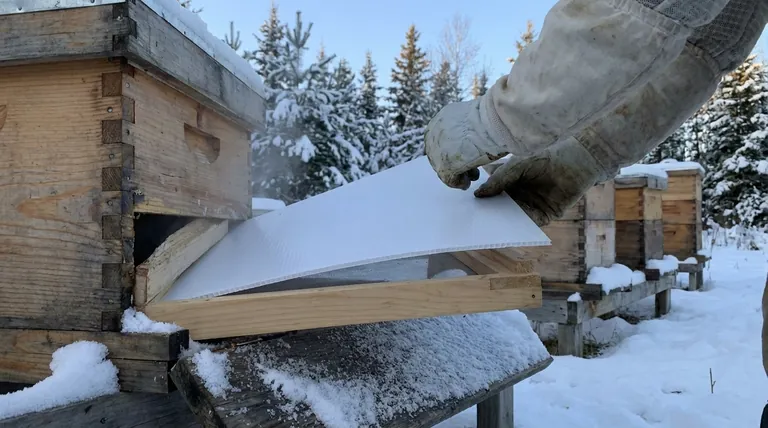In cold climates, a screened bottom board presents a critical trade-off between heat retention and moisture control. While it does allow more heat to escape compared to a solid board, its primary role in winter is to provide essential ventilation. This ventilation helps remove excess moisture, which is often a greater threat to a colony's survival than the cold itself.
The core challenge for a beehive in winter is not just the cold, but the deadly combination of cold and dampness. A screened bottom board sacrifices some insulation to excel at removing moisture, making it a viable and often preferred tool for wintering bees when managed correctly.

The Core Conflict: Heat vs. Moisture
To understand the role of a bottom board, you must first understand how a honeybee colony survives the winter. They do not heat the entire hive cavity; they only heat themselves.
How a Bee Cluster Manages Heat
Bees form a tight cluster and vibrate their wing muscles to generate heat, keeping the center of the cluster at a stable, warm temperature. They consume their stored honey as fuel for this activity. The outer layer of bees acts as a thick blanket of insulation.
The Dangers of Trapped Moisture
As bees consume honey and breathe, they release a significant amount of water vapor. In a poorly ventilated hive with a solid bottom, this warm, moist air rises, hits the cold inner cover, and condenses. This condensation can drip back down onto the cluster, chilling and killing the bees.
The Role of a Screened Bottom Board
A screened bottom board provides a crucial escape route for this moisture-laden air. It promotes a natural convection current, allowing cold, dry air to enter from the bottom and push the warm, wet air out through an upper entrance. A dry cluster is far more capable of surviving cold temperatures than a damp one.
Understanding the Trade-offs
Using a screened bottom board in winter is not without its considerations. You are making a conscious decision to prioritize dryness over maximum insulation.
Increased Food Consumption
Because the hive is less insulated from the bottom, the cluster will need to burn more honey to maintain its core temperature. It is critical that a colony wintered on a screened bottom has ample honey stores to serve as fuel.
Reduced Varroa Mite Loads
A key year-round benefit is pest management. Varroa mites, a devastating parasite, will occasionally fall off their host bee. With a screened bottom, these mites fall out of the hive and cannot crawl back in, permanently reducing the pest population without chemicals.
Exposure to Wind
An open screen can create a wind tunnel if the hive is not properly situated. Hives with screened bottoms should be protected from prevailing winter winds, either by a natural windbreak or by wrapping the hive stand.
The Modern Solution: The Insertable Tray
Most modern screened bottom boards are not simply open screens; they come equipped with an insertable tray, often made of corrugated plastic. This tray fundamentally changes the dynamic.
Gaining the Best of Both Worlds
The insertable tray allows you to control the amount of ventilation. You can leave the screen fully open during the fall to monitor Varroa mite drops, then slide the tray in during the coldest parts of winter to reduce drafts and increase heat retention.
A Tool for Fine-Tuning
Even with the tray inserted, many beekeepers leave a small gap at the back. This blocks direct wind but still allows moisture to drain and provides a small amount of ventilation. This adaptability makes the screened bottom board a versatile tool rather than a fixed liability.
Making the Right Choice for Your Hive
Your decision should be based on your management style and specific climate conditions.
- If your primary focus is maximum insulation and simplicity: A solid bottom board can work, but you must be diligent about providing an upper entrance and other means for moisture to escape.
- If your primary focus is adaptability and integrated pest management: A screened bottom board with an insertable tray offers superior flexibility to manage ventilation, moisture, and Varroa mites throughout the year.
Ultimately, choosing the right equipment comes from understanding the fundamental needs of your bees for a dry, well-fed, and healthy winter.
Summary Table:
| Key Consideration | Screened Bottom Board Impact |
|---|---|
| Moisture Control | Excellent - prevents condensation buildup |
| Heat Retention | Reduced - colony may consume more honey |
| Varroa Mite Control | Good - aids in natural mite drop management |
| Wind Exposure | Can be high - requires wind protection |
| Flexibility | High - with an insertable tray for adjustment |
Ensure your apiary is equipped for success in any season. HONESTBEE supplies durable, high-quality screened bottom boards and other essential beekeeping supplies to commercial apiaries and beekeeping equipment distributors. Our wholesale-focused operations ensure you get the reliable equipment you need to support healthy, productive hives. Contact our team today to discuss your needs and place your order.
Visual Guide

Related Products
- Langstroth Screen Bottom Board for Beekeeping Wholesale
- Australian Pine Wood Langstroth Screen Bottom Board for Wholesale
- Inner Beehive Cover for Beekeeping Bee Hive Inner Cover
- HONESTBEE Wooden Bee Escape Board with Triangle Mesh Design for Beekeeping
- Professional Galvanized Hive Strap with Secure Locking Buckle for Beekeeping
People Also Ask
- What are the benefits of a screened bottom board? Boost Hive Health & Control Varroa Mites
- What are the benefits of using a screened bottom board in warm or humid climates? Boost Hive Health & Control Pests
- What are the assembly options for the Cypress Screened Bottom Board? Ready-to-Use for Immediate Hive Health
- What are the main benefits of using a Screened Bottom Board in beekeeping? Enhance Hive Health & Productivity
- What is the primary function of a screened bottom board in a hive? Enhance Ventilation & Control Varroa Mites



















